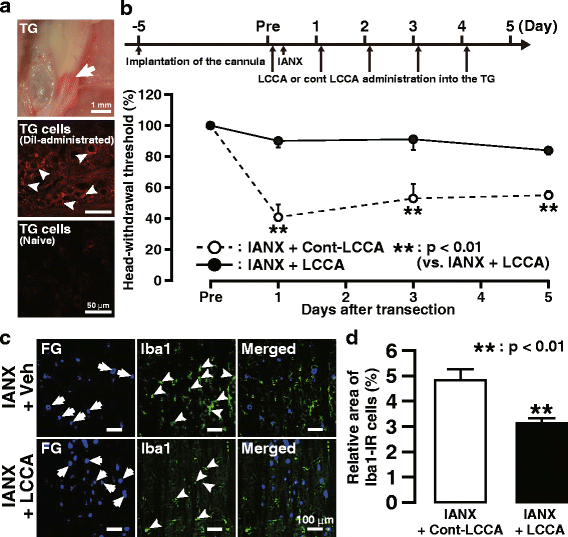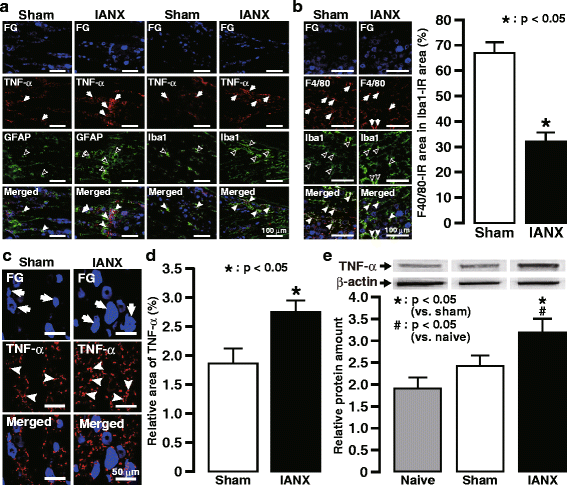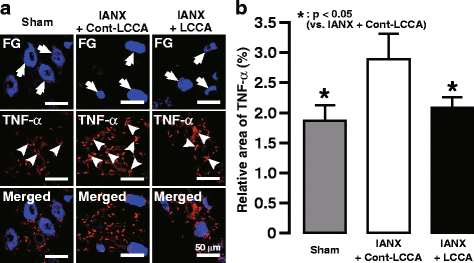Macrophages in trigeminal ganglion contribute to ectopic mechanical hypersensitivity following inferior alveolar nerve injury in rats
- PMID: 29246259
- PMCID: PMC5732495
- DOI: 10.1186/s12974-017-1022-3
Macrophages in trigeminal ganglion contribute to ectopic mechanical hypersensitivity following inferior alveolar nerve injury in rats
Abstract
Background: Accidental mandibular nerve injury may occur during tooth extraction or implant procedures, causing ectopic orofacial pain. The exact mechanisms underlying ectopic orofacial pain following mandibular nerve injury is still unknown. Here, we investigated the role of macrophages and tumor necrosis factor alpha (TNFα) in the trigeminal ganglion (TG) in ectopic orofacial pain following inferior alveolar nerve transection (IANX).
Methods: IANX was performed and the mechanical head-withdrawal threshold (MHWT) in the whisker pad skin ipsilateral to IANX was measured for 15 days. Expression of Iba1 in the TG was examined on day 3 after IANX, and the MHWT in the whisker pad skin ipsilateral to IANX was measured following successive intra-ganglion administration of the macrophage depletion agent liposomal clodronate Clophosome-A (LCCA). TNFα expression in the TG and the MHWT in the whisker pad skin ipsilateral to IANX following successive intra-ganglion administration of the TNFα blocker etanercept were measured on day 3 after IANX, and tumor necrosis factor receptor-1 (TNFR1) immunoreactive (IR) cells in the TG were analyzed immunohistochemically on day 3.
Results: The MHWT in the whisker pad skin was significantly decreased for 15 days, and the number of Iba1-IR cells was significantly increased in the TG on day 3 after IANX. Successive intra-ganglion administration of the macrophage depletion agent LCCA significantly reduced the increased number of Iba1-IR cells in the TG and reversed the IANX-induced decrease in MHWT in the whisker pad skin. TNFα expression was increased in the TG on day 3 after IANX and was reduced following successive intra-ganglion administration of the TNFα inhibitor etanercept. The decreased MHWT was also recovered by etanercept administration, and TNFR1-IR cells in the TG were increased on day 3 following IANX.
Conclusions: These findings suggest that signaling cascades resulting from the production of TNFα by infiltrated macrophages in the TG contributes to the development of ectopic mechanical allodynia in whisker pad skin following IANX.
Keywords: Ectopic orofacial pain; Inferior alveolar nerve transection; Macrophage; Mechanical allodynia; Trigeminal ganglion; Tumor necrosis factor alpha.
Conflict of interest statement
Ethics approval
The experimental protocols including all the surgical procedures and animal usages conformed to the guidelines for the care and use of laboratory animals by the National Institutes of Health Guide for the Care and Use of Laboratory Animals and the guidelines of the International Association for the Study of Pain. This study was approved by the Animal Experimentation Committee at Nihon University (AP16D010).
Consent for publication
Not applicable.
Competing interests
The authors declare that they have no competing interests.
Publisher’s Note
Springer Nature remains neutral with regard to jurisdictional claims in published maps and institutional affiliations.
Figures





Similar articles
-
Age-related Changes in Trigeminal Ganglion Macrophages Enhance Orofacial Ectopic Pain After Inferior Alveolar Nerve Injury.In Vivo. 2023 Jan-Feb;37(1):132-142. doi: 10.21873/invivo.13062. In Vivo. 2023. PMID: 36593019 Free PMC article.
-
Connexin 43 contributes to ectopic orofacial pain following inferior alveolar nerve injury.Mol Pain. 2016 Mar 8;12:1744806916633704. doi: 10.1177/1744806916633704. Print 2016. Mol Pain. 2016. PMID: 27030716 Free PMC article.
-
Involvement of Satellite Cell Activation via Nitric Oxide Signaling in Ectopic Orofacial Hypersensitivity.Int J Mol Sci. 2020 Feb 13;21(4):1252. doi: 10.3390/ijms21041252. Int J Mol Sci. 2020. PMID: 32070010 Free PMC article.
-
Peripheral and Central Mechanisms of Persistent Orofacial Pain.Front Neurosci. 2019 Nov 13;13:1227. doi: 10.3389/fnins.2019.01227. eCollection 2019. Front Neurosci. 2019. PMID: 31798407 Free PMC article. Review.
-
Non-neuronal cells act as crucial players in neuropathic orofacial pain.J Oral Biosci. 2024 Sep;66(3):491-495. doi: 10.1016/j.job.2024.07.005. Epub 2024 Jul 18. J Oral Biosci. 2024. PMID: 39032826 Review.
Cited by
-
Macrophage biology in the peripheral nervous system after injury.Prog Neurobiol. 2019 Feb;173:102-121. doi: 10.1016/j.pneurobio.2018.12.001. Epub 2018 Dec 21. Prog Neurobiol. 2019. PMID: 30579784 Free PMC article. Review.
-
Assessment of Growth Factors, Cytokines, and Cellular Markers in Saliva of Patients with Trigeminal Neuralgia.Molecules. 2021 May 17;26(10):2964. doi: 10.3390/molecules26102964. Molecules. 2021. PMID: 34067581 Free PMC article.
-
Evidence for glial reactivity using positron-emission tomography imaging of translocator Protein-18 kD [TSPO] in both sham and nerve-injured rats in a preclinical model of orofacial neuropathic pain.Neurobiol Pain. 2024 Dec 12;17:100175. doi: 10.1016/j.ynpai.2024.100175. eCollection 2025 Jan-Jun. Neurobiol Pain. 2024. PMID: 39758133 Free PMC article.
-
Dynamic alterations in M2 macrophage subtypes enhance flap expansion efficiency and tissue regeneration.Cell Biochem Biophys. 2024 Jun;82(2):859-871. doi: 10.1007/s12013-024-01237-5. Epub 2024 Mar 5. Cell Biochem Biophys. 2024. PMID: 38441826
-
P2X3 receptor upregulation in trigeminal ganglion neurons through TNFα production in macrophages contributes to trigeminal neuropathic pain in rats.J Headache Pain. 2021 Apr 26;22(1):31. doi: 10.1186/s10194-021-01244-4. J Headache Pain. 2021. PMID: 33902429 Free PMC article.
References
MeSH terms
Substances
Grants and funding
LinkOut - more resources
Full Text Sources
Other Literature Sources
Miscellaneous

